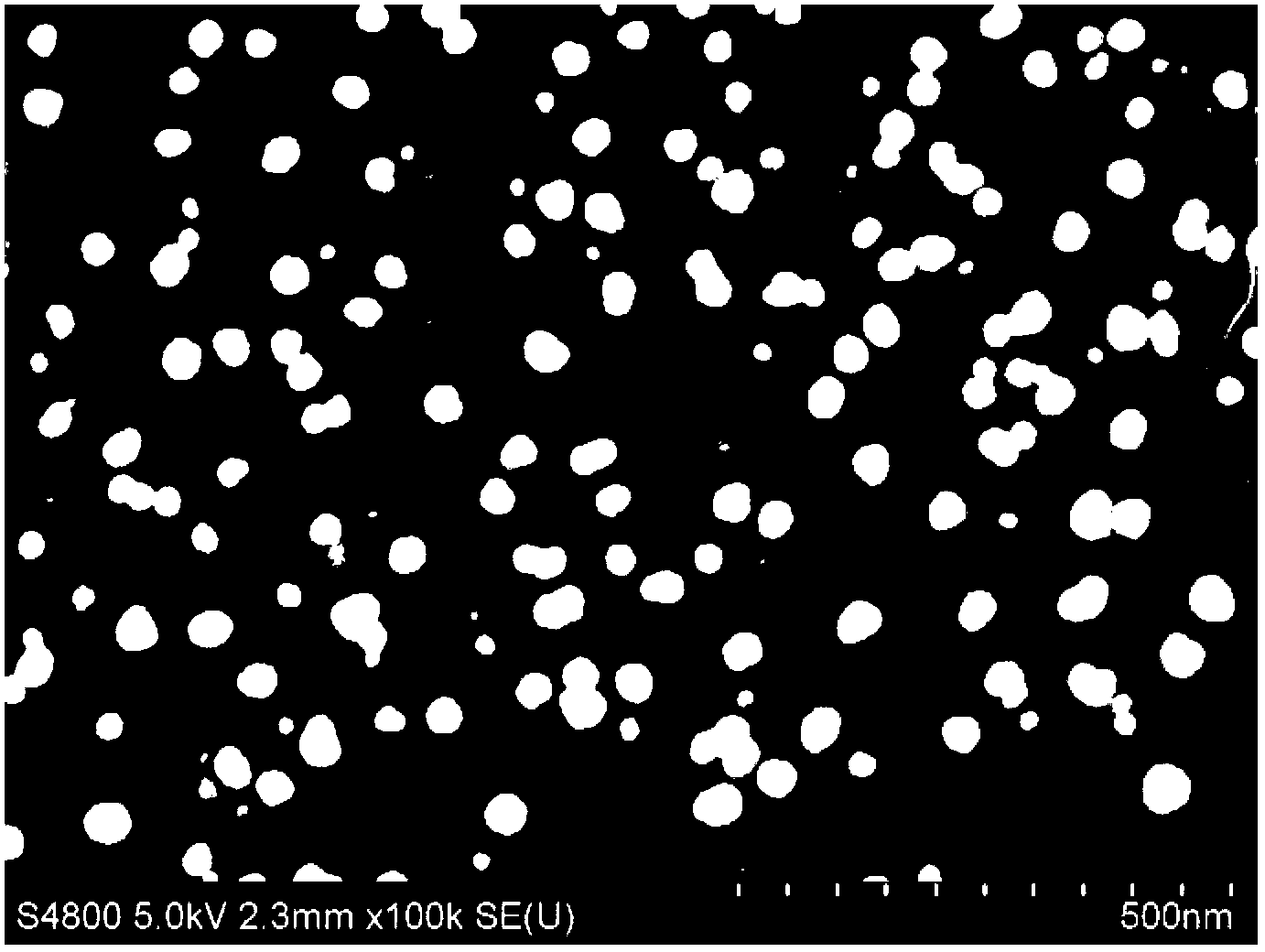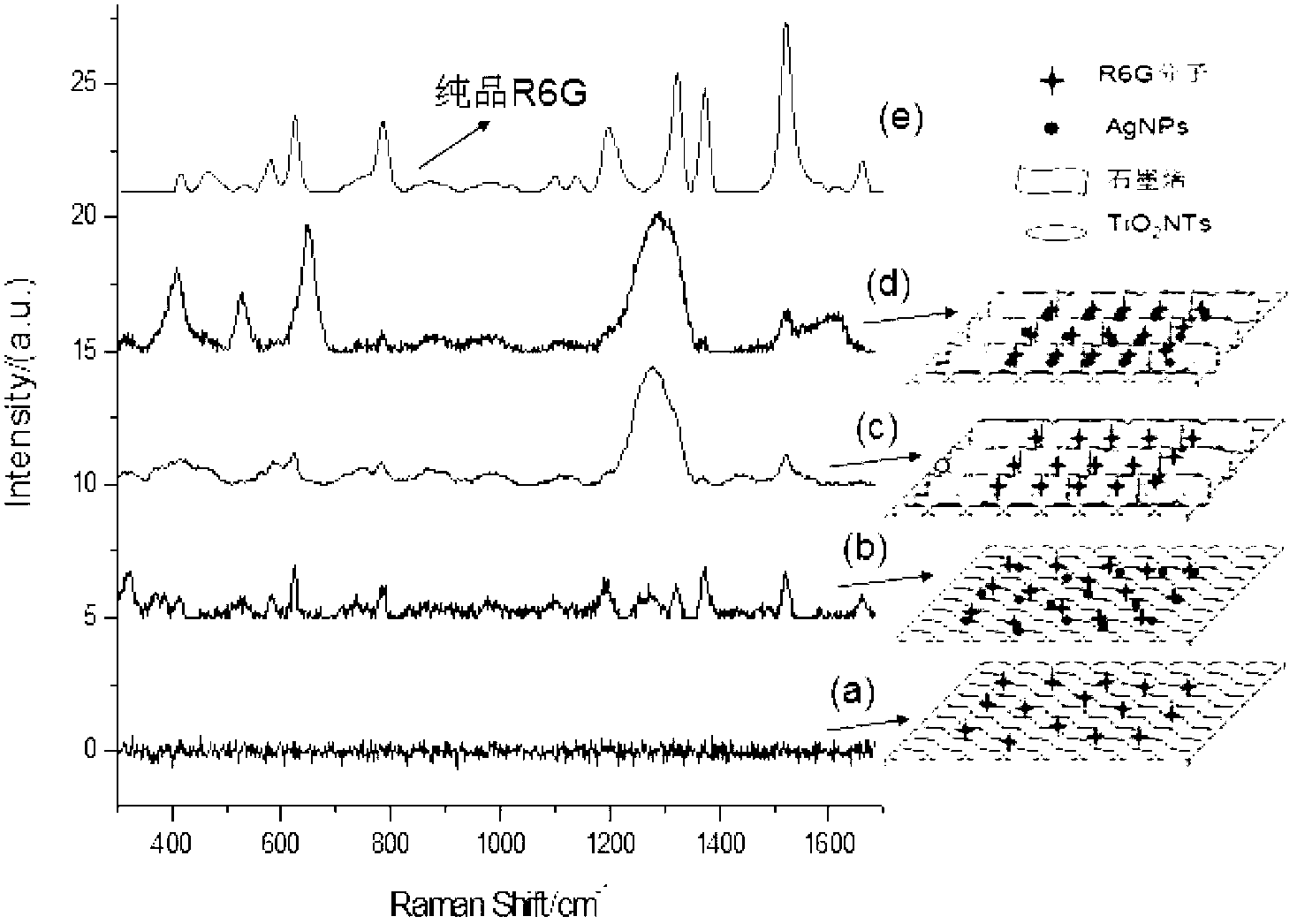Raman reinforced substrate material, preparation and application methods thereof
A technology of substrate materials and application methods, applied in the directions of Raman scattering, material excitation analysis, nanotechnology, etc., can solve the problems of expensive, complicated pretreatment, time-consuming, etc., and achieve short detection time, rapid detection, and simple sample processing Effect
- Summary
- Abstract
- Description
- Claims
- Application Information
AI Technical Summary
Problems solved by technology
Method used
Image
Examples
Embodiment 1
[0021] Preparation of Raman-enhanced substrate materials:
[0022] 1) Use acetone to ultrasonically remove the dirt on the surface of the titanium sheet, and then wash it with ethanol; use HF solution (concentration of 0.01mol / L~0.5mol / L) to wash off the oxides and impurities on the surface, and after drying, immerse the clean titanium sheet in In the electrolyte of 0.5mol / LNaF, the platinum sheet is used as the cathode, and the titanium sheet is used as the anode, and the anodic oxidation treatment is carried out at 10V-15V under DC power supply for 1h-3h, and the pore diameter is 90nm-100nm, the length is 300nm-350nm, and the effective electrode is prepared. TiO with an area of length 4cm×width 1cm-2cm 2 Nanotube array, washed and dried for later use;
[0023] 2) Sonicate graphite oxide powder in 0.1M pH 9.0 PBS buffer for 30min; form a uniform brown graphite oxide electrolyte with a concentration of 0.1mg / mL-0.5mg / mL; then reduce it by cyclic voltammetry, using three ele...
Embodiment 2
[0027] Raman-enhanced substrate of the present invention is used for R6G (rhodamine 6G) analysis
[0028] The Raman-enhanced composite material was cut into a square with a size of 5 mm × 5 mm as the substrate for Raman detection. A standard solution of 1mM R6G was prepared, and a series of concentrations were prepared by layer-by-layer dilution. Use a pipette gun to draw 20 μL of the solution of the corresponding concentration and drop it on the Raman substrate prepared above. After it is naturally absorbed and dried, use a Voyage confocal Raman microscope for Raman detection (such as Figure 3-4 ), the Raman excitation wavelength is 785nm. This material can be used as a substrate to measure the Raman characteristic peak of the R6G solution with the lowest concentration of 0.1nM, so the material can be used as an effective surface Raman enhanced substrate.
Embodiment 3
[0030] Benzo(a)pyrene sample analysis and detection
[0031] Take 10L Xiangjiang water, use solid phase extraction method to extract and enrich benzo(a)pyrene in Xiangjiang water; choose 5mL / min as the sample loading volume flow rate to ensure high analyte recovery and save sample processing time; sample solution After passing through the extraction column, nitrogen gas was passed through for 10 minutes to dry the sample. Use dichloromethane as the eluent of the solid-phase extraction column to elute the enriched material, and then use nitrogen to remove the eluent and dry the sample. Use acetone to dissolve it, add the benzopyrene sample solution dropwise on the base material at normal temperature and pressure, and use the Voyage confocal Raman microscope for Raman detection after natural drying ( Figure 5 ). The test results were compared with the Raman characteristic peaks of pure benzo(a)pyrene directly detected by Raman spectrometer, and it was found that at 332cm -1 ...
PUM
 Login to View More
Login to View More Abstract
Description
Claims
Application Information
 Login to View More
Login to View More - R&D
- Intellectual Property
- Life Sciences
- Materials
- Tech Scout
- Unparalleled Data Quality
- Higher Quality Content
- 60% Fewer Hallucinations
Browse by: Latest US Patents, China's latest patents, Technical Efficacy Thesaurus, Application Domain, Technology Topic, Popular Technical Reports.
© 2025 PatSnap. All rights reserved.Legal|Privacy policy|Modern Slavery Act Transparency Statement|Sitemap|About US| Contact US: help@patsnap.com



